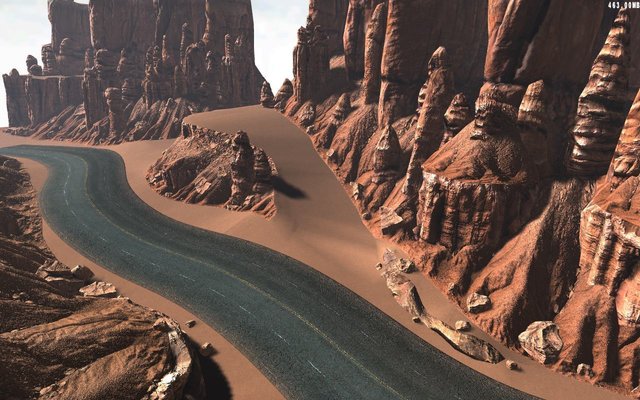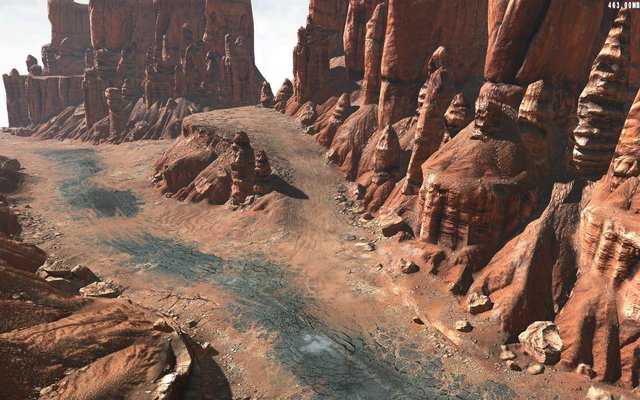MultiTexture
A method for blending multiple textures together on the same mesh, by painting a mask between them. Also called "texture splatting". Often Vertex Color is used to control the blending because vertex color is fairly cheap. Or a mask bitmap can be used because it gives more control and avoids the gradient artifacts of per-vertex blending.
Texture Splatting
- Vertex Painting in UDK - Eat 3D Video tutorial by Tor 'Snefer' Frick showing how to use vertex painting in UDK.
- UDN - Three - Terrain Advanced Textures by Epic Games. Multiple methods for multitexturing terrain in the Unreal 3 Engine.
- texturing a race track thread on Polycount. Texturing ideas for race track pavement.
- Multitexturing and decals? thread on Polycount. Multitexturing methods explained.
- Dark Sector multitexturing by Mario 'Strangefate' Vazquez, Polycount thread here, some explanations here. Using vertex blending to multitexture gritty urban scenes.
Modulation Blending
This method adds sharp details to the blend area, by mixing vertex color (for the larger blend) with grayscale textures (for the sharp detail blend). These grayscale maps are either stored in the alpha channel of each layer's normal map, or multiple maps can be channel packed into a single map. Usually the shader has a control for how sharp the transition will be, and sometimes you can use a vertex color or bitmap to control the sharpness.
- Vertex blend shader for Unity shader and Youtube video by Sindre 'Fingus 'Opsahl Skaare
- An exercise in modular textures - Scifi lab UDK - by Tor 'Snefer' Frick, an exercise in extreme texture atlasing, packing multiple maps into the four channels of a texture file.
- The Desert(What can you do with no diffuse maps?) Polycount forum thread. Vertex blending using multiple modulation textures, in UDK. See also Ditching Diffuse Maps: A foray into artistic reasoning and technical details behind "procedural" texturing, with practical examples on today's tech by Andrew 'd1ver' Maximov.
- UDK - snow on top of rocks shader ideas, via the Epic Games Forums.
- Tutorial - Gradient Mapping & UDK Polycount forum thread. Using gradients to control colors in an image or as a postprocess.
- The Snow and Ice of Uncharted2? Polycount forum thread. Vertex blending using a modulation texture. Test shaders for UDK (1, 2, 3, 4, 5 (snow)). Behrooz Roozbeh from Naughty Dog explains how they did it over here on ZBrushCentral.
- UDN - Three - Landscape Materials by Epic Games. UDK's Landscape system uses painted weightmaps for terrain multitexturing. The weightmaps are one pixel per vertex, but you can also enable modulate textures using a Landscape Layer Blend node with the "LB_!HeightBlend" option.
- UT3: Vertex color blending variation by Chris Albeluhn. Creating advanced vertex blending materials in UDK using vertex color and modulation masks. See also UDK Advanced Vertex Painting.
- Advanced Mesh Paint with UDK ($) at 3DMotive by Ryan James Smith. Creating advanced vertex blending materials in UDK using vertex color and a modulation mask.
- $blendmodulatetexture at the Valve Developer Community wiki. How to use a modulation texture in Source.
- Custom Blend Materials in Source at forums.tf2maps.net by Cynick. Creating advanced vertex blending materials in Source using vertex color and a modulation mask.
Sub-Tiles
Multiple tiling textures can be packed into a single bitmap, and cropped out by a shader. This saves texture fetches, at the expense of increasing shader instructions.
- UDN - Three - TerrainAdvancedTextures - Texture Packing: Implementing large texture tile sets
- UDK - how to solve 'frac' artifacts and mipmapping seams - how to implement sub-tiles in UDK, and solve seams.
- UDK - Material - Multi-UV Changes - more UDK techniques for sub-tiles.
- Terrain texture atlas construction - how to properly compile sub-tiles into a large texture sheet.
Variation Blending
Methods for adding variation across a tiling texture.
- STAGE Street Fighter 2, Bath House, JordanW - Polycount Forum]
- Chris Albeluhn - UT3 - Adding variation to a repeating texture pattern
- Chris Albeluhn - UT3 - Adding Brick Variation
- Chris Albeluhn - UDK - Mesh Position Offset the Materials Texture
Megatexture
id Software's Megatexture tech uses [[Decal decals] and multitexturing to create their terrain textures, which are then baked down in a preprocessing step into a huge texture sheet, that's dynamically loaded as you play the game. So it's not really multitexturing in the end, blending in real-time, instead it's a single colormap baked from a multitextured source. The Splash Damage wiki has an article about generating Megatextures for ETQW.

